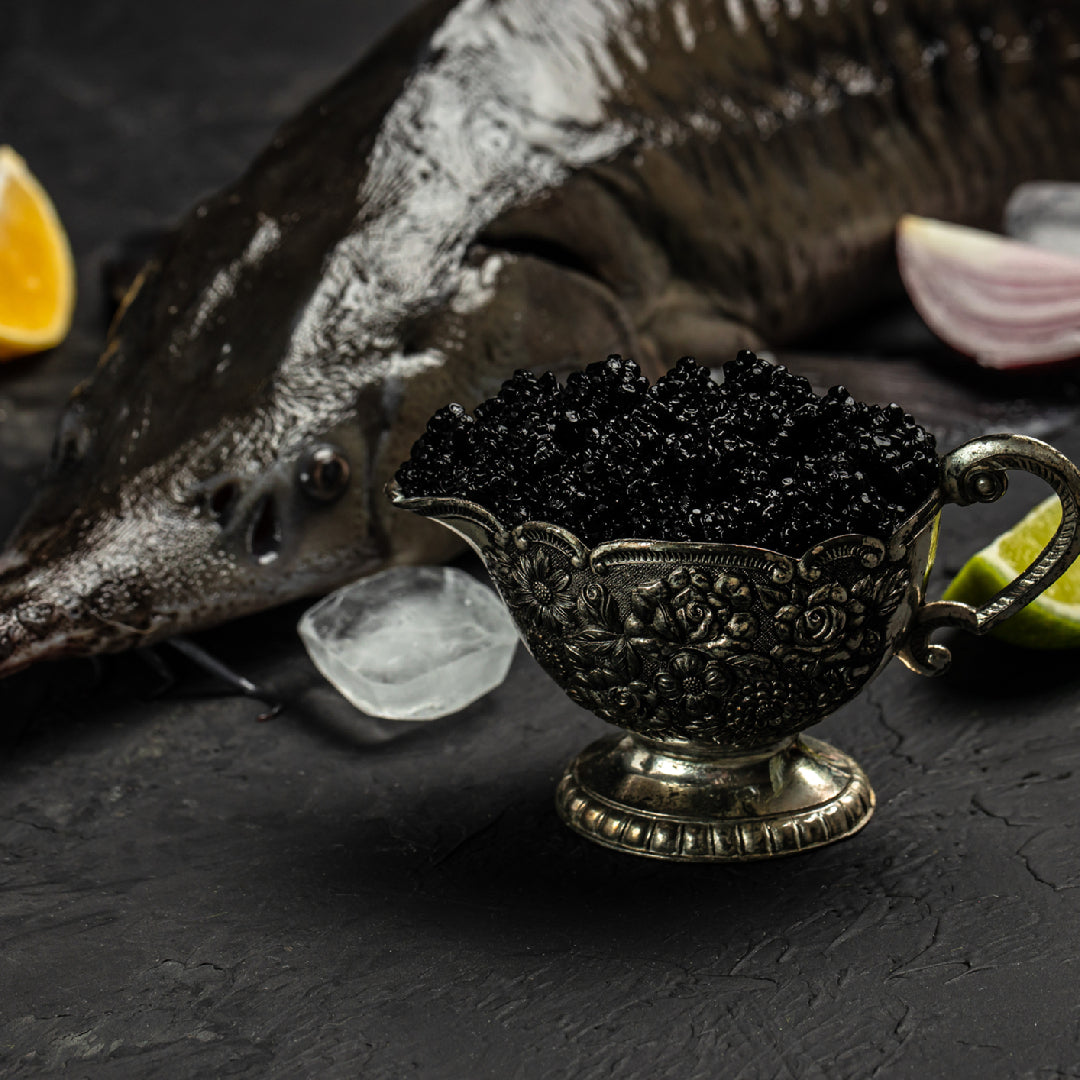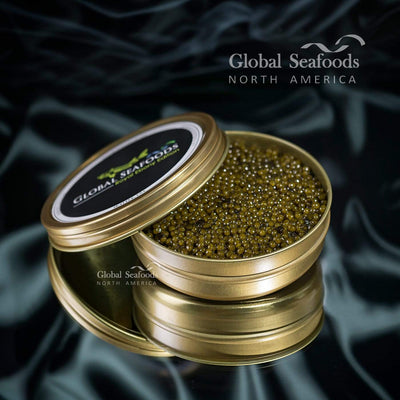Why Kaluga Caviar is Among the World’s Most Expensive Caviars

Kaluga Caviar World’s Most Expensive Caviars
Caviar has long been a symbol of luxury, with certain varieties reaching extraordinary prices. Among these, Kaluga caviar stands out as one of the most sought-after and expensive. Known for its rich, buttery taste, large pearls, and sustainable production, Kaluga caviar appeals to discerning palates who demand only the best. But why is Kaluga caviar so prized? This guide will dive deep into the factors that make Kaluga caviar one of the most valuable delicacies, from its complex production process to its sophisticated flavor profile.
Looking for high-quality Kaluga caviar? Browse Global Seafoods’ selection for authentic and premium caviar, along with other luxury options like Beluga, Ossetra, and Sevruga caviars.
What is Kaluga Caviar?
Kaluga caviar is derived from the Kaluga sturgeon, native to the Amur River basin along the border of Russia and China. Often referred to as the “river Beluga” for its similarity to the famous Beluga caviar, Kaluga caviar boasts large, firm pearls and a flavor that combines a buttery, slightly briny richness with delicate undertones. Sustainable farming practices make Kaluga caviar an eco-friendly option compared to wild-sourced caviars, adding to its appeal and exclusivity.
A Sustainable Alternative to Beluga
Kaluga sturgeon caviar offers a more sustainable and environmentally conscious alternative to Beluga caviar, which has been impacted by overfishing and environmental degradation. As the demand for sustainable luxury rises, Kaluga caviar stands as a premium choice that aligns with eco-friendly practices, maintaining quality without compromising on ethics.
Chef and caviar expert Eric Ripert states, “The finest caviars today balance taste with environmental responsibility.” Kaluga caviar exemplifies this by providing a luxurious experience rooted in sustainability.
Why is Kaluga Caviar So Expensive?
Several factors contribute to the high price of Kaluga caviar, making it one of the most expensive types of caviar on the market:
1. Time-Intensive Farming and Harvesting
The Kaluga sturgeon requires up to 15 years to reach maturity, a lengthy process that limits production and raises costs. Unlike many farm-raised fish, Kaluga sturgeon are carefully tended to ensure they produce only the highest quality roe, requiring extensive resources and expertise. This lengthy maturation period directly affects the price, as each batch of Kaluga caviar represents years of careful cultivation.
2. Unique Flavor and Texture Profile
Kaluga caviar offers a distinctive taste that’s unmatched by other varieties. Its large, firm pearls “pop” with a rich, creamy flavor, leaving a delicate briny aftertaste. The buttery texture and complex flavors are especially appealing to gourmet enthusiasts, making Kaluga caviar a preferred choice for upscale dining and special occasions.
3. Limited Supply and High Demand
Kaluga sturgeon are raised in controlled environments to ensure quality and sustainability, but this also limits the supply. The rarity of the product, combined with a growing global demand for sustainable luxury, makes Kaluga caviar both exclusive and expensive.
4. Premium Packaging and Presentation
Kaluga caviar is typically packaged in high-quality, airtight containers that preserve its freshness and enhance its luxurious presentation. Many suppliers also offer gift packaging, adding an extra touch of sophistication. This premium packaging ensures that consumers receive the best possible quality, but it also adds to the overall cost.
For a selection of the finest caviars, including Kaluga, visit Global Seafoods, where attention to quality and sustainable sourcing is paramount.
How Does Kaluga Caviar Compare to Other Expensive Caviars?
Kaluga caviar is often compared to other high-end varieties like Beluga, Ossetra, and Sevruga. Each has its unique characteristics and appeals to different palates.
Kaluga Caviar vs. Beluga Caviar
Beluga caviar is known for its large, soft pearls and rich, buttery flavor. However, due to its endangered status, Beluga caviar is heavily restricted in many countries. Kaluga caviar provides a sustainable alternative with a similar taste and texture, making it a popular choice among luxury caviar enthusiasts.
Kaluga Caviar vs. Ossetra Caviar
Ossetra caviar, derived from the Ossetra sturgeon, has a nutty, earthy flavor with smaller pearls compared to Kaluga. While both are celebrated for their quality, Kaluga caviar’s larger pearls and milder, creamy taste make it a top choice for those who prefer a more delicate flavor.
Kaluga Caviar vs. Sevruga Caviar
Sevruga caviar is known for its intense, briny flavor and smaller pearls. This caviar is often preferred by those who enjoy a bolder taste, whereas Kaluga caviar’s buttery profile and larger pearls offer a more refined experience.
Discover various types of caviar, including Beluga, Ossetra, and Sevruga, at Global Seafoods for a range of luxury options.
How to Serve Kaluga Caviar: Tips for the Ultimate Luxury Experience
Kaluga caviar is best enjoyed with simple accompaniments that let its unique flavor shine. Here are some tips for serving this delicacy:
Serving Temperature and Presentation
Kaluga caviar should be served chilled, ideally at around 28°F to 32°F. Present it on a bed of crushed ice in its original tin or in a crystal bowl. Avoid using metal utensils, as they can alter the taste. Instead, opt for mother-of-pearl, bone, or ceramic spoons.
Classic Pairings for Kaluga Caviar
- Champagne: Dry champagne pairs perfectly with Kaluga caviar, adding a crisp contrast to the caviar’s creamy texture.
- Vodka: A classic choice, especially when served ice-cold, vodka enhances the caviar’s briny notes without overpowering its natural flavor.
- White Wine: For a light pairing, select a dry white wine like Chablis or Sauvignon Blanc, which complements the caviar’s subtle richness.
For more pairing ideas and caviar inspiration, visit Global Seafoods’ YouTube channel for expert guidance.
The Health Benefits of Kaluga Caviar
Beyond its luxurious appeal, Kaluga caviar is also rich in nutrients, offering several health benefits:
- High in Omega-3 Fatty Acids: Known for supporting heart health, reducing inflammation, and enhancing cognitive function.
- Source of Lean Protein: A high-quality protein source that supports muscle repair and immune health.
- Rich in Essential Vitamins and Minerals: Contains Vitamin B12, selenium, and iron, all of which are vital for overall health.
According to Harvard Health, “Omega-3 fatty acids play a crucial role in maintaining cardiovascular health and brain function.” Kaluga caviar provides these beneficial nutrients, making it a nutritious indulgence.
Frequently Asked Questions About Kaluga Caviar
1. Why is Kaluga caviar so expensive?
Kaluga caviar’s high price is due to its lengthy production process, premium quality, limited supply, and high demand for sustainable luxury foods.
2. How should I store Kaluga caviar?
Store unopened Kaluga caviar in the coldest part of the refrigerator. Once opened, consume within 2-3 days for optimal freshness.
3. Can I cook with Kaluga caviar?
While Kaluga caviar is best enjoyed on its own or as a garnish, it can also be used to enhance gourmet dishes such as pasta, risotto, and seafood.
4. What’s the best way to serve Kaluga caviar at a gathering?
Serve Kaluga caviar chilled with accompaniments like blinis, toast points, and crème fraîche. For beverages, offer guests champagne, vodka, or a crisp white wine.
5. Where can I buy authentic Kaluga caviar online?
For top-quality Kaluga caviar, visit Global Seafoods, a trusted source for premium caviar and seafood.
Conclusion: Why Kaluga Caviar is the Pinnacle of Luxury
Kaluga caviar represents the ultimate in luxury, offering a buttery taste, large pearls, and sustainable sourcing that appeals to gourmet enthusiasts worldwide. Whether you’re enjoying it alone or with friends, Kaluga caviar provides a refined experience that reflects a commitment to quality and taste.
Ready to indulge? Discover premium Kaluga caviar and other luxury options like Beluga, Ossetra, and Sevruga at Global Seafoods, and elevate your next dining experience with the world’s finest caviars.
Also in News

How to Make Sea Bream Sushi With Dry-Aged Tuna & Crab Roll — Step-by-Step With Chef Joshua
A complete guide to making Sea Bream sushi at home, including filleting, curing, slicing, and building a Dry-Aged Tuna & Crab sushi roll. Chef Joshua shares professional tips for restaurant-quality results.

Boiled Crab for Game Night: Everything You Need for a Perfect Seafood Party
Take your game night to the next level with a Boiled crab party. Learn the best recipes, cooking tips, and hosting hacks for a memorable seafood feast.

Boiled Crab for Date Night: A Romantic Guide to the Perfect Seafood Feast
Make your next date night unforgettable with a romantic Boiled crab experience. This guide covers everything you need to know, from ambiance to the best crab varieties.

